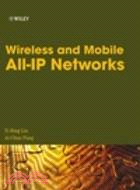| FindBook |
|
有 1 項符合
YI-BING LIN的圖書 |
 |
$ 850 ~ 1140 | WIRELESS AND MOBILE ALL-IP NETWORKS
作者:YI-BING LIN 出版社:全華經銷 出版日期:2005-01-01 規格:24*19cm / 精裝 / 504頁  共 2 筆 → 查價格、看圖書介紹 共 2 筆 → 查價格、看圖書介紹
|
|
|
- 圖書簡介
Looks at the number one advancement currently emerging from 3GPP (Third Generation Partnership Project) in global wireless growth: the development of wireless applications based only on the Internet Protocol (IP) which drives the Web
Focusing on the emerging all-IP core network and applications, this book covers
3G and shows how the all-IP core network can be developed and how applications can be created
Contains review questions and their solutions at the end of each chapter, all of which have been tested, as well as models for implementation - 作者簡介
Yi-Bing Lin is chair professor of the Department of Computer Science and Information Engineering (CSIE), National Chiao Tung University (NCTU). He also serves as vice president of the Office of Research and Development, NCTU (2005–2006). Dr. Lin is a senior technical editor of IEEE Network, an editor of IEEE Transactions on Wireless Communications, an associate editor of IEEE Transactions on Vehicular Technology, an editor of IEEE Wireless Communications Magazine, an editor of ACM Wireless Networks, program chair for the 8th Workshop on Distributed and Parallel Simulation, general chair for the 9th Workshop on Distributed and Parallel Simulation, program chair for the 2nd International Mobile Computing Conference, guest editor for the ACM MONET special issue on Personal Communications, guest editor for IEEE Transactions on Computers special issue on Mobile Computing, guest editor for IEEE Transactions on Computers special issue on Wireless Internet, and guest editor for IEEE Communications Magazine special issue on Active, Programmable, and Mobile Code Networking. Lin is co-author of the book Wireless and Mobile Network Architecture (with Imrich Chlamtac; published by John Wiley & Sons). Lin received 1997, 1999, and 2001 Distinguished Research Awards from the National Science Council, ROC; the 2005 Pan, Wen-Yuen Outstanding Research Award; the 2004 K.-T. Li Breakthrough Award; and the 1998 Outstanding Youth Electrical Engineer Award from CIEE, ROC. He also received the NCTU Outstanding Teaching Award in 2002. Lin is an Adjunct Research Fellow of Academia Sinica, and is an adjunct chair professor of Providence University. He is also an IEEE Fellow, an ACM Fellow, an AAAS Fellow, and an IEE Fellow.
Ai-Chun Pang received B.S., M.S., and Ph.D. degrees in Computer Science and Information Engineering from National Chiao Tung University. She joined the Department of Computer Science and Information Engineering, National Taiwan University, Taipei, Taiwan, as an Assistant Professor in 2002 and an Associate Professor in 2006. Since August 2004, Dr. Pang has also joined in the Graduate Institute of Networking and Multimedia, National Taiwan University, Taipei, Taiwan. Her research interests include design and analysis of personal communications services networks, mobile computing, voice over IP, and performance modeling. - 目次
Acknowledgments.
Introduction.
1 Short Message Service and IP Network Integration.
1.1 SMS-IP Integration with SM-SC.
1.2 iSMS System Architecture.
1.3 iSMS Communication Protocols.
1.4 Examples of Services.
1.5 Caching for iSMS-Based Wireless Data Access.
1.6 Concluding Remarks.
1.7 Questions.
2 Mobility Management for GPRS and UMTS.
2.1 Network Architectures.
2.2 Concepts of Mobility Management.
2.3 Mobility Management States.
2.4 MM and PDP Contexts.
2.5 Attach and Detach.
2.6 Location Update.
2.7 Serving RNC Relocation.
2.8 UMTS-GPRS Intersystem Change.
2.9 Concluding Remarks.
2.10 Questions.
3 Session Management for Serving GPRS Support Node.
3.1 Session Management Functions.
3.2 SM Software Architecture.
3.3 SM Software Initiation and Configuration.
3.4 SM Procedures in the SGSN.
3.5 Concluding Remarks.
3.6 Questions.
4 Session Management for Gateway GPRS Support Node.
4.1 APN Allocation.
4.2 IP Address Allocation.
4.3 PDP Context Activation.
4.4 Tunneling between UMTS and External PDN.
4.5 Quality of Service.
4.6 Concluding Remarks.
4.7 Questions.
5 Serving Radio Network Controller Relocation for UMTS.
5.1 SRNC Duplication.
5.2 Core Network Bi-casting.
5.3 Fast SRNC Relocation.
5.4 Comparison of the Relocation Mechanisms.
5.5 Concluding Remarks.
5.6 Questions.
6 UMTS and cdma2000 MobileCore Networks.
6.1 UMTS and cdma2000 Protocol Stacks.
6.2 Mobility and Session Management Mechanisms.
6.3 IP Mobility.
6.4 UMTS and cdma2000 Interworking.
6.5 Concluding Remarks.
6.6 Questions.
7 UMTS Charging Protocol.
7.1 The GTP’ Protocol.
7.2 Connection Setup Procedure.
7.3 GTP’ CDR Transfer Procedure.
7.4 GTP’ Failure Detection.
7.5 Concluding Remarks.
7.6 Questions.
8 Mobile All-IP Network Signaling.
8.1 Signaling System Number 7.
8.2 Stream Control Transmission Protocol (SCTP).
8.3 UMTS Network Signaling.
8.4 UMTS MAP Software Architecture.
8.5 TCAP and SCCP Based on M3UA.
8.6 MAP Message Delivery.
8.7 SCTP and MTP Approaches.
8.8 Concluding Remarks.
8.9 Questions.
9 UMTS Security and Availability Issues.
9.1 Authentication Signaling for UMTS.
9.2 Fraudulent Usage in UMTS.
9.3 Eavesdropping a Mobile User.
9.4 HLR Failure Restoration.
9.5 Concluding Remarks.
9.6 Questions.
10 VoIP for the Non-All-IP Mobile Networks.
10.1 GSM-IP: VoIP Service for GSM.
10.2 vGPRS: VoIP Service for GPRS.
10.3 Concluding Remarks.
10.4 Questions.
11 Multicast for Mobile Multimedia Messaging Service.
11.1 Existing Multicast Mechanisms for Mobile Networks.
11.2 The SMS Multicast Approach III.
11.3 The MMS Multicast Approach IV.
11.4 Concluding Remarks.
11.5 Questions.
12 Session Initiation Protocol.
12.1 An Overview of SIP.
12.2 SIP-based GPRS Push Mechanism.
12.3 SIP-based VoIP Prepaid Mechanism.
12.4 Concluding Remarks.
12.5 Questions.
13 Mobile Number Portability.
13.1 Number Portability for Mobile Telecommunications Networks.
13.2 Call Routing Mechanisms with Number Portability.
13.3 Number Porting and Cost Recovery.
13.4 Concluding Remarks.
13.5 Questions.
14 Integration of WLAN and Cellular Networks.
14.1 The WGSN Approach.
14.2 Implementation of WGSN.
14.3 Attach and Detach.
14.4 WGSN Push Mechanism.
14.5 IEEE 802.1X-based Authentication.
14.6 Concluding Remarks.
14.7 Questions.
15 UMTS All-IP Network.
15.1 All-IP Architecture.
15.2 All-IP Core Network Nodes.
15.3 Registration and Call Control.
15.4 Open Service Access.
15.5 Efficiency of IP Packet Delivery.
15.6 Concluding Remarks.
15.7 Questions.
16 Issues for the IP Multimedia Core Network Subsystem.
16.1 Caching in I-CSCF.
16.2 Integrated Authentication for GPRS and IMS.
16.3 Concluding Remarks.
16.4 Questions.
17 A Proxy-based Mobile Service Platform.
17.1 iProxy Middleware.
17.2 iMobile Service Platform.
17.3 User and Device Management.
17.4 iMobile-based Peer-to-Peer Mobile Computing.
17.5 Concluding Remarks.
17.6 Questions.
Bibliography.
Index.
|










